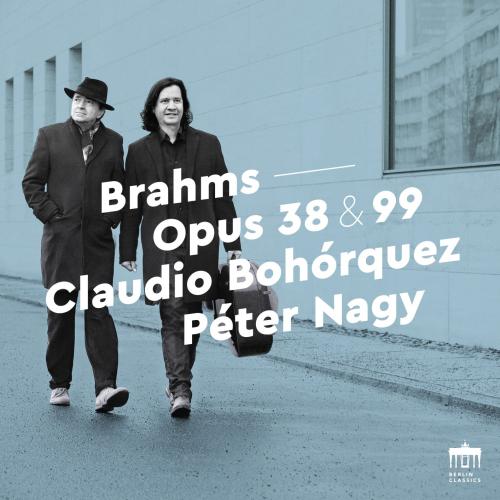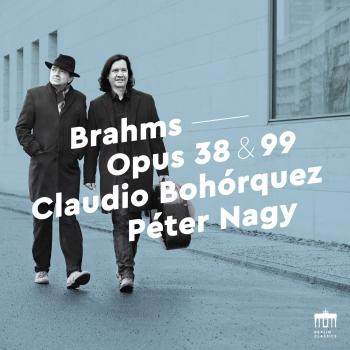
Brahms: Opus 38 & 99 (Sonatas for Piano and Cello) Claudio Bohórquez
Album info
Album-Release:
2018
HRA-Release:
25.07.2018
Label: Berlin Classics
Genre: Classical
Subgenre: Chamber Music
Artist: Claudio Bohórquez
Composer: Johannes Brahms (1833-1897)
Album including Album cover Booklet (PDF)
- Johannes Brahms (1833 - 1897): Cello Sonata no. 1, Op. 38 in E Minor:
- 1 I. Allegro non troppo 13:44
- 2 II. Allegretto quasi Menuetto 05:21
- 3 III. Allegro 06:45
- Cello Sonata no. 2, Op. 99 in F Major:
- 4 I. Allegro vivace 09:23
- 5 II. Adagio affettuoso 07:07
- 6 III. Allegro passionato 07:01
- 7 IV. Allegro molto 04:39
- Hungarian Dances:
- 8 No. 5 in F Minor 02:22
- 9 No. 1 in G Minor 03:32
- 10 No. 7 in C Major 02:33
- Fünf Gesänge, Op. 105 no. 1:
- 11 Wie Melodien zieht es mir 02:28
Info for Brahms: Opus 38 & 99 (Sonatas for Piano and Cello)
Claudio Bohórquez has established himself as an experienced chamber musician and concert soloist. For the past 30 years and more he has been playing the cello, teaching at the famous Hanns Eisler conservatoire in Berlin and travelling the world from the USA to Japan and from Argentina to Russia.
Now the moment has come for him to attend to his discography. "The time is right," as he says. He learnt early on, from colleagues he trusted and admired, how important it was to take one's time. No snap decisions – musical ideas needed to mature, interpretations had to be based on personal experience, and self-awareness was essential.
He begins where he first started out. The Sonatas for piano and cello opp. 38 & 99 by Johannes Brahms loom large in the life of each and every cellist. Like others before and since, he tackled these works at an early age. In the Hungarian pianist Péter Nagy, he has found the perfect musical partner.
Brahms was especially fond of the cello: we know that from the countless themes, leading lines and heartfelt melodies that the composer entrusted to the instrument. In his youth, he had "played the fiddle a bit, but my instrument was the cello," as Brahms told the Viennese music critic Herberger.
The Hungarian Dances, serving as a foil – almost as an encore – to the two sonatas, were written at a time when Hungarian refugees were settling in Brahms's native city of Hamburg. The demand from the aspiring middle classes for sophisticated but playable music, suitable for domestic performance, was one of the secrets of success for the Hungarian Dances. The arrangement by Alfredo Piatti is the currently preferred version for piano and cello.
The musical starting signal has rung out. Claudio Bohórquez is not stopping at Brahms, he has much more to give us. It sounds good!
Claudio Bohórquez, cello
Péter Nagy, piano
Claudio Bohórquez
is receiving attention from conductors, fellow musicians, audiences, concert presenters and critics alike as one of the most exciting and fascinating young artists of his generation. He divides his attention between concerto appearances with an impressive array of international orchestras and conductors, solo recitals, chamber music projects and festivals and collaborating with a wide spectrum of visual and performing artists in special projects.
Claudio Bohórquez is a pupil of Boris Pergamenschikow. While winning a number of international competitions at an early age, he was further brought to the music world’s attention for receiving the top prize in the first International Casals Competition in Germany in 2000. He also received a special award for chamber music in this competition and, as part of the award, was allowed to perform on Maestro Casals famed Gofriller cello for several years. His previous competitions include a.o. the Youth Tchaikovsky Competition in Moscow, the International Rostropovich Competition in Paris and the Geneva International Music Competition. He became a member of BBC Radio 3’s New Generation Artists scheme in 2002.
Mr. Bohórquez has performed with the Orchestre de Paris, Tonhalle Orchester Zürich, Deutsches Symphonie-Orchester Berlin, the Radio-Sinfonie-Orchester Frankfurt, the Leipzig Gewandhausorchester, the Münchner Symphoniker, the Staatskapelle Dresden, the NDR Sinfonieorchester Hamburg, the Wiener Symphoniker, the Orchestre de la Suisse Romande and the Orchestre philharmonique de Radio France. In Japan, he has appeared both with the NHK Symphony (including two nationally televised concerts) and the Tokyo Philharmonic. In the United States he has recently appeared with the Boston Symphony, the Chicago Symphony, the Cleveland Orchestra, the Detroit Symphony, the Los Angeles Philharmonic, the National Symphony and the Philadelphia Orchestra.
Conductors with whom he has worked include Daniel Barenboim, Herbert Blomstedt, Thomas Dausgaard, Rafael Frühbeck de Burgos, Christoph Eschenbach, Hans Graf, Yakov Kreizberg, Sir Neville Marriner, Krzysztof Penderecki, Leonard Slatkin and David Zinman.
Booklet for Brahms: Opus 38 & 99 (Sonatas for Piano and Cello)









